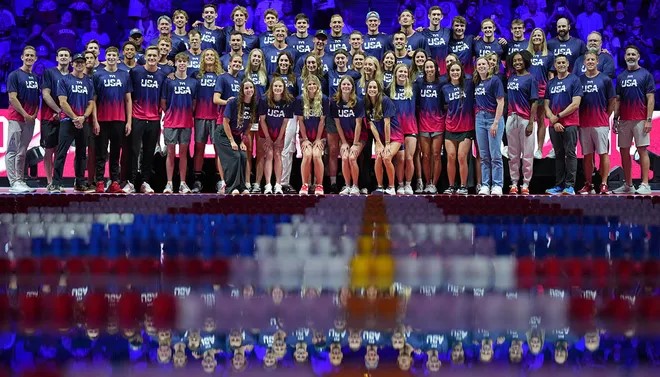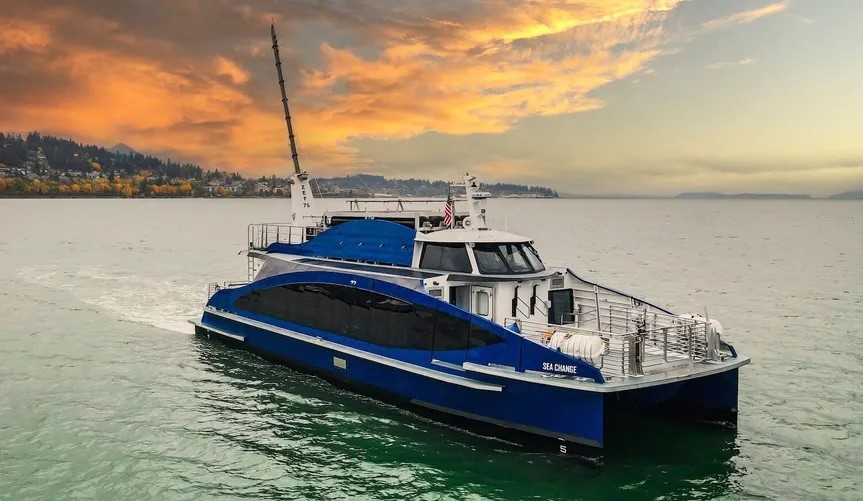07/18/24
Best of the West: Meet the Olympians from the West; hydrogen-powered ferries; buffalo restoration; Oregon fighter jet; Spanish-language interpreting; more efficient devices; Oklahoma housing

The Western Governors' Association keeps you updated on the latest news in the West. Here are the top stories for the week starting July 15, 2024. (Photos courtesy of Switch Maritime, The Office of Governor Tina Kotek, Ralph Lauren, and Grace Hollars, IndyStar / USA TODAY NETWORK).
Olympic fever is hitting the West, with the Paris Olympic Games slated to begin on July 26th and the Paralympic Games to start on August 28th. Olympians from the West make up a dominant portion of the 592-athlete Olympic roster with 285 Olympians and Paralympians from the West heading to Paris. Paralympic qualifying still ongoing.
California boasts the country’s most Olympians, with 133 competing from the Golden State. Another 46 will head to Paris from Texas, and 29 from Colorado.
Headlining Team USA are western athletes like Texans Simone Biles in gymnastics, Brittney Griner in basketball, and Sha’Carri Richardson in track.
In golf, the American four-man team is loaded with western talent. Xander Schauffele and Collin Morikawa hail from California, and Wyndham Clark is from Colorado.
Both Men’s and Women’s basketball teams are the overwhelming favorites to take Olympic gold, with westerners like Jrue Holiday, Sabrina Ionescu, Kelsey Plum, and recent NBA champion Derrick White set to take the court in Paris.
In soccer, the women’s team is full of regional players, especially Coloradans, with Lindsay Horan, Sophia Smith, and Mallory Swanson all hailing from the state.
Other western highlights include breakout swimming star from Nevada, Katie Grimes, Colorado’s Anna Hall in the heptathlon, and Californians Nyjah Huston competing in skateboarding and Chase Budinger in volleyball.
skateboarding and Chase Budinger in volleyball.
With American Paralympic qualifiers still ongoing, Team USA will grow with more headline-worthy athletes from the West, such as Ezra Frech in track and field, and Eric Newby and Josh O’Neill in wheelchair rugby.
Check out the Team USA map showing the hometowns of the entire Olympic team.
Though the opening ceremony of the Paris Games is just days away, Olympic fans in the West are already looking forward to the global spectacle coming back to the region, as it’s likely that two Olympic Games will be held in the West within the next decade.
Preparations are already well underway for the next summer Olympics in 2028, which will be held for the third time in Los Angeles. Organizers have announced the sites for a number of the events in 2028, with at least eight events scheduled to take place downtown and another seven slated to be held in Long Beach.
Los Angeles is an experienced Olympic host, having held both the 1932 and 1984 Games, and in 2028 it will become the first North American city to host three Olympics. The L.A. Memorial Coliseum will become the first stadium to do so as well.
Looking all the way ahead to 2034, Salt Lake City appears poised to host its second Winter Olympic Games. The International Olympic Committee (IOC) will make its official announcement of the host for the 2034 Games on July 24th, and Salt Lake City will be waiting in anticipation to hear its name called.
The city will host a July 24 watch party for the announcement, and Governor Spencer Cox is expected to travel to Paris for a final pitch before the IOC makes its decision.
If Salt Lake is selected to host the Games, a recent report from the University of Utah projects that the state could generate $6.6 billion in economic impact from the event. Last time Salt Lake City hosted the Winter Games in 2002, it resulted in a surplus of $163 million.
The report expects Utah to keep the costs of hosting the events low by using the infrastructure it built in 2002 again in 2034. The state does not plan to build new facilities for the Games, should it win the bid for 2034.
Hydrogen ferry: The world’s first commercial passenger ferry completely powered by zero-emission hydrogen fuel cells has launched in San Francisco. After nearly five years in development, the startup Switch Maritime deployed the 75-passenger ferry in the San Franciso Bay. The vessel will carry passengers for free three days a week during a six-month trial period, as of July 19th.
Ma rny of the nearly 620 commercial ferries in the countryun on worn-out diesel engines, which contribute a disproportionate amount of emissions in many harbors, compared to the relatively low number of vessels. In response, many harbors are turning toward battery-operated ferries as a solution. Ferry operators in Washington and California are investing significant resources in battery-powered ferries, with billions being invested across both states to convert existing ferries and build the necessary charging infrastructure for them.
Proponents of hydrogen-powered ferries point out that implementing more battery technology weighs down ferries, causing them to travel slower and cover shorter distances before needing to be recharged. Hydrogen, on the other hand, provides a lighter power system and cuts out the need to recharge. Around the world, a few dozen hydrogen-powered watercraft projects have launched in recent decades, but the San Francisco ferry will be the first such project to operate commercially.
Buffalo restoration: Jason Baldes, an Eastern Shoshone Tribal member in Wyoming, recently received the National Geographic Wayfinder Award for his work restoring the buffalo population on the Wind River Reservation.
In 2017, Baldes played an important role in the first buffalo calf being born on the reservation in 130 years, and he has led the effort to restore the buffalo population through the Wind River Tribal Buffalo Initiative ever since.
The Wayfinder Award annually recognizes individuals who have made a large impact in their respective fields and communities, and winners are often National Geographic explorers, scientists, conservationists, researchers, storytellers, or educators.
Oregon fighter jet: Oregon Governor Tina Kotek joined the National Guard Bureau and the Oregon Military Department for the unveiling of the first F-15EX Eagle II fighter jet at the 142nd wing of the Oregon National Guard. The 142nd Wing joins two other Air National Guard units currently operating the F-15EX fighter jet.
“Oregon’s location in our nation places us in a critical position for national air defense. Today’s unveiling is a historic moment for our state and our nation,” Governor Kotek said.
Spanish-language interpreting: With growing Spanish-speaking populations in western mountain towns, the need for interpreting services is also increasing. To fill this gap, Spanish speakers in communities like Jackson Hole, Salt Lake City, and Santa Fe are stepping up to provide interpretive services for their community members, with interpreting businesses popping up all over the region.
Giovanna Carriero-Contreras, who trains interpreters in the Mountain West, says that interpreting services require more than just translating and repeating back what someone said. It requires understanding regional dialects and tones in order to help Spanish speakers convey their message, especially in the context of government meetings or other public settings.
Smaller devices: According to a recent paper published in the journal Nature, scientists at the Lawrence Berkeley National Laboratory appear to have made a significant step towards making electronic devices smaller and more efficient.
Researchers at the Berkeley Lab have developed tiny components called microcapacitors, which could allow energy to be stored directly on a device’s microchip, eliminating much of the energy loss that occurs as energy is transferred between multiple parts inside a device.
"The energy and power density we got are much higher than we expected," said Sayeef Salahuddin, the UC Berkeley professor who led the project. "We've been developing negative capacitance materials for many years, but these results were quite surprising."
Oklahoma housing: Multiple housing stories are in the news in Oklahoma this week, with projects ongoing in Oklahoma City and Ponca City.
In the state’s capital, plans are set to revitalize the city’s oldest public housing complex. Originally built in 1937, Will Rogers Court lacks modern necessities like shower heads and central air conditioning. The plans would demolish the current structure and replace it with the same number of affordable units and add more affordable and market-rate units. The plans also envision bringing a new grocery store, new businesses, and neighborhood organizations to the area.
In Ponca City, a town of 24,000, the Development Authority is investing $1 million into housing projects over the next three years to address the area’s growth and subsequent housing shortages. The town hopes that the investment will help draw developers, which often opt to build in more populated areas, leaving rural parts of the state without sufficient housing.